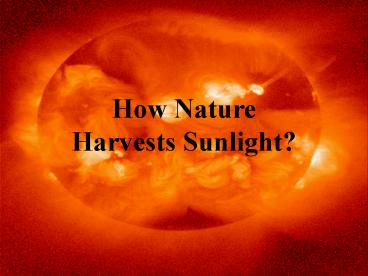How Nature Harvests Sunlight - PowerPoint PPT Presentation
1 / 16
Title:
How Nature Harvests Sunlight
Description:
Photosynthetic organisms-plants,algea and photosynthetic bacteria- have ... autotrophic bacteria which use inorganic reactions as a source ... – PowerPoint PPT presentation
Number of Views:27
Avg rating:3.0/5.0
Title: How Nature Harvests Sunlight
1
How Nature Harvests Sunlight?
2
It is through photosynthesis that Earths
biosphere derives its energy from sunlight.
Photosynthetic organisms-plants,algea and
photosynthetic bacteria- have developed efficient
systems to harvest sunlight and to use its energy
to drive their metabolic reactions, such as the
reduction of carbon dioxide to sugar.
3
(No Transcript)
4
(No Transcript)
5
Z Scheme - plants
light absorption generates proton motive
force (PMF) and a reducing power (NADH/NADPH).
PMF is used to generate ATP
ATP and NAD(P)H are used to fix CO2 . the
supply of ATP and NAD(P)H dont have to come
from light energy.
autotrophic bacteria which use inorganic
reactions as a source of energy, can often also
fix CO2 .
6
Antenna complex
Light is absorbed by chlorophyll located in
photosynthetic membranes an e-
is released from the chlorophyll and travels
down an e- transport chain. But actually only a
few special chlorophyll molecules in the reaction
centre (RC) release electrons.
Most of the chlorophyll is found in the antenna
which absorbs light energy and funnels it to
the reaction centre. A typical antenna contains
chlorophylls, proteins and carotenoids.
7
Photosynthetic organisms 3 main
classes 1.cyanobacteria and green plants
(chloroplasts) production of O2 oxygenic
photosystems I and II fix CO2 2.photosyntheti
c eubacteria no O2 is produced anaerobic
only photosystem I 2 types of light harvesting
complexes sometimes fix CO2 but need an
external reducant such as H2S or
succinate.
8
3.halobacteria no chlorophyll no
photosynthetic e- transport possess a light
driven proton pump which produces energy,
but no reducing power. need a source of
organic carbon cant fix CO2
9
Generation of PMF 2 protons are
translocated across the membrane, for each
electron which goes Around this loop. This
creates The PMF which is used to make ATP.
This is known as cyclic photophosphorylation by
analogy to oxidative phosphorylation.
Generation of reducing power Higher plants-
NADPH Purple bacteria-NADH-they do so by reversed
electron transport. Since electrons are not
returned to the P960 they must be replaced. For
Purple bacteria the e- donor is H2S or
thiosulfate. Non sulfur bacteria use organic
donor such as malate/succinate.
10
Evolution of photosynthesis
It is a complex process involving distinct
origins and pathways of many different
components.- and as such it cannot be
described by a simple, linear branching pathway.
The emergence of Mg tetrapyrroles and reaction
centre apoproteins Was the key event that led to
the advent of photosynthesis.
Anoxygenic photosynthesis evolved prior to
oxygenic photosynthesis. The order in which the
ability to generate energy evolved is generally
considered to be 1. Anaerobic fermantation ATP
converted to PMF 2. Anaerobic photosynthesis
light converted to PMF 3. Oxygenic
photosynthesis light converted to PMF and oxygen
4. Respirationreverse electron transport chain
uses O2
11
Cindy Lee Van Dover - The woman and the idea
She wondered if photosynthetic bacteria might
live near hydrothermal vents. a striking
speculation!
12
Water emerges from hydrothermal vents at hundreds
of degrees and kept from boiling only by intense
pressure. Her speculation was that the hot water
and perhaps hot rocks, would emit infra-red
radiation and some bacteria might absorb it just
the way algea and land plants absorb sunlight.
13
Paul Falkowski
The men and the legend FRR FLUOROMETER
Zbigeniew Kolber
14
Fast rate repetition (FRR) Fluorometer
They developed a methosd of detecting
photosynthesis from changes in the fluorescence
of chlorophyll in the photosynthetic apparatus
of phytoplankton.
They hit the cells with pulses of light ,
effectively charging up the chlorophyll.
After its absorbed enough pulses, chlorophyll
reemits light as fluorescence.
Different types of chlorophyll fluoresce at
different wave lengths.
15
After checking and calibrating the detector in
the lab on known bacteria, they headed to sea
with the deep-sea submersible
Alvin
16
18 dives later it was very clear that there where
no detectable photosynthetic bacteria in
deep-sea vents!
They decided to look around at water samples from
the surface.
And they where indeed surprised!































